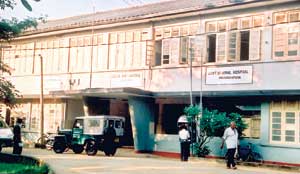Ten mothers and around 160 babies have died within the first seven months of this year at the Anuradhapura Teaching Hospital causing much concern in health circles.
The babies include both ‘perinatal’ or those still in the womb between 28 and 42 weeks and ‘neonatal’ or those who are a week-old, the Sunday Times understands.
In Sri Lanka, a highpoint is that the Maternal Mortality Ratio is equivalent to those in developed countries. Then what has gone wrong at the Anuradhapura Teaching Hospital?
Sri Lanka’s Maternal Mortality Ratio for 2007 (the last official figure available) is 38.4 deaths per 100,000 live births, it is learnt. In simpler terms, in 2007, only 144 mothers died countrywide due to pregnancy and related complications.
According to this data, these 144 deaths were for 380,000 deliveries in 2007. However, this year, at the Anuradhapura Hospital 10 mothers have died in the first seven months for around 9,000 deliveries, it is learnt.
If this trend continues, the Maternal Mortality Ratio for the Anuradhapura Hospital alone may hit a high 111 for 100,000 live births, a simple calculation indicates.
While medical circles in Colombo buzzed with speculation that one of the two Visiting Obstetricians and Gynaecologists (VOGs) was more at a private hospital in Colombo engaging in private practice rather than at his station at Anuradhapura, top level hospital sources stressed that these allegations were unfounded.
Overcrowding and lack of facilities as well as staff are the major contributory factors for these deaths, explained Anuradhapura Hospital Director Dr. D.B. Wijekoon when contacted by the Sunday Times.
Referring to the situation at the hospital, he said that it not only catered to patients from the Anuradhapura district which had a population of 800,000 but also to patients transferred from Vavuniya, Mannar and some areas of the North Western Province.
Pointing out that the lack of space was a serious issue, Dr. Wijekoon said there were only two VOGs who share one ward and handle 15,000 deliveries each year. Further breaking down the figures, he said that there were around 1,250 deliveries a month, with about 40 a day.
This Teaching Hospital has only a 10-bed labour room, the Sunday Times learns and sometimes there is a mother in labour in each bed every six hours.
It is difficult to keep the linen etc. clean and dry when ideally only two mothers should occupy a bed within a day, said the Director, lamenting that there was also a shortage of nurses.
The baby unit is also overcrowded. This has increased the risk of cross-infection while there are no nurses to give one-to-one care to the premature babies, he said.
His claim was corroborated by other sources as well. “There is a lack of facilities such as a vital blood-gas machine to monitor the babies in the Premature Baby Unit,” a source said.
The mothers’ deaths were due to both direct and indirect causes, Dr. Wijekoon said and cited late admission to hospital, coming in a serious condition which could not be reversed, complicated diseases as some of the contributory factors.
Asked about the face-off between nurses and midwives in the labour room as to who should have the privilege of wielding the scissors and cutting the umbilical cord which joins the baby to the mother, the Director said that issue had been settled a year ago and had no bearing on the situation.
Meanwhile, health sources said the situation at the Anuradhapura Hospital should be treated as an emergency in the light of the fact that if the trend continued the Maternal Mortality Ratio would be very high for the whole district while having a bearing on the national ratio as well.
“This will be irrespective of the fact that patients are coming in from areas outside Anuradhapura district,” the source pointed out.
Director Dr. Wijekoon assured that all deaths were being investigated not only by the hospital but also by the Judicial Medical Officer in urgent moves to nip the downward slide and arrangements were also underway to expand the obstetric ward to provide more space for expectant mothers in the next two months.
It is mandatory that more facilities should be provided to this Teaching Hospital, which is attending to such a large number of patients, to prevent mothers and babies dying there, one health source stressed
Another source added: “the crucial things that need to be looked into by the Health Ministry are whether the hospital has minimum standards; adequate equipment, facilities and staff; staff with knowledge and skills which are enhanced regularly; and whether higher authorities carry out regular audits.” |


